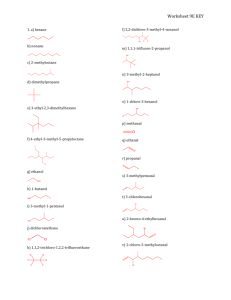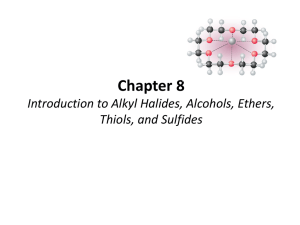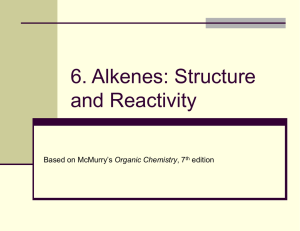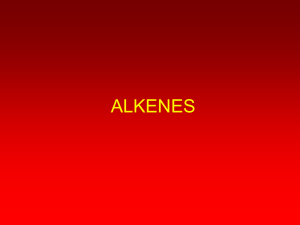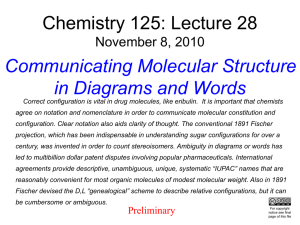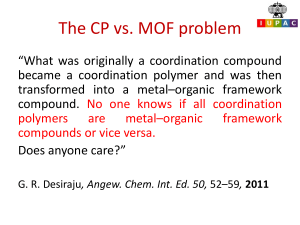Chapter 4
advertisement
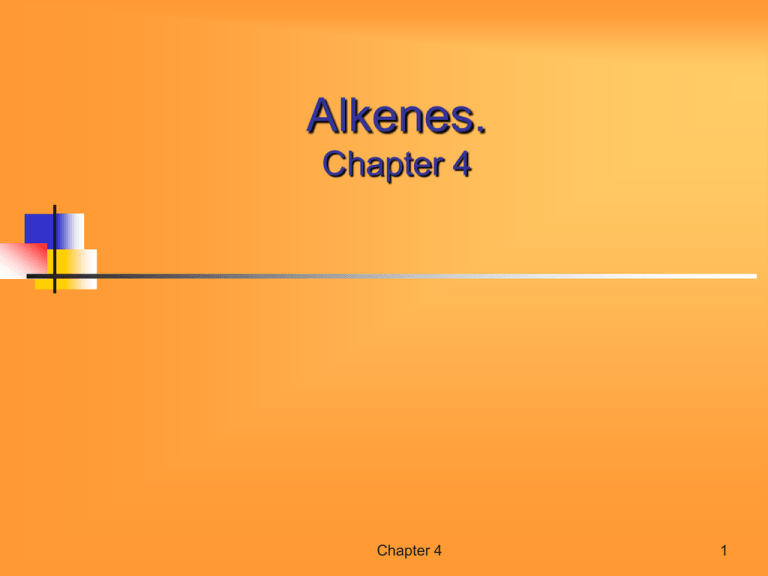
Alkenes. Chapter 4 Chapter 4 1 Contents of Chapter 3 General Formulae and Nomenclature of Alkenes Cis-Trans Isomerism Reactivity Considerations Thermodynamics and Kinetics Chapter 4 2 General Molecular Formula for Alkenes General molecular formula for acyclic alkanes is CnH2n+2 CH3CH2CH2CH2CH3 an alkane C5H12 CnH2n+2 Chapter 4 3 General Molecular Formula for Alkenes Each bond introduced, reduces the H content by 2 CH3CH2CH2CH=CH2 an alkene C5H10 CnH2n Chapter 4 4 General Molecular Formula for Alkenes Each ring also reduces the H content by 2 a cyclic alkane C5H10 CnH2n Chapter 4 5 General Molecular Formula for Alkenes Generalization: The molecular formula for a hydrocarbon is CnH2n+2 minus 2 hydrogens for every bond and/or ring present in the molecule Each bond or ring is considered a unit of unsaturation. C 5 H8 CnH2n-2 a cyclic alkene with 2 units of unsaturation Chapter 4 6 Saturated and Unsaturated Hydrocarbons Alkanes or saturated hydrocarbons contain the maximum number of carbon-hydrogen bonds CH3CH2CH2CH2CH3 a saturated hydrocarbon Chapter 4 7 Saturated and Unsaturated Hydrocarbons Alkenes contain fewer than the maximum number of carbon-hydrogen bonds and are therefore referred to as unsaturated hydrocarbons CH3CH2CH2CH=CH2 an unsaturated hydrocarbon Chapter 4 8 Nomenclature of Alkenes IUPAC names of alkenes are based on the corresponding alkane with “ane” replaced by “ene” Chapter 4 9 IUPAC Rules for Alkene Nomenclature 1. The longest chain containing the functional group (the double bond) is numbered such that the double bond is the lowest possible number Chapter 4 10 IUPAC Rules for Alkene Nomenclature 2. If there are substituents, the chain is still numbered in a direction that gives the double bond the lowest number Chapter 4 11 IUPAC Rules for Alkene Nomenclature 3. If chain has more than one substituent, they are cited in alphabetical (not numerical) order. Rules for alphabetizing are the same as for alkanes Chapter 4 12 IUPAC Rules for Alkene Nomenclature 4. If the same number for the double bond is obtained in both directions, number in the direction that gives lowest number to a substituent. Chapter 4 13 IUPAC Rules for Alkene Nomenclature 5. In cyclic compounds, a number is not needed to denote the position of the functional group The double bond is assumed to be between carbons 1 and 2 Chapter 4 14 IUPAC Rules for Alkene Nomenclature 6. If both directions yield same low number for a functional group and for one substituent, number in the direction which yields the lower number for one of the remaining substituents Chapter 4 15 IUPAC Rules for Alkene Nomenclature Two groups containing double bonds that are used as names for substituents are the vinyl group and the allyl group Chapter 4 16 IUPAC Rules for Alkene Nomenclature The sp2 carbons of an alkene are called vinylic An sp3 adjacent carbon is called allylic Chapter 4 17 IUPAC Nomenclature of Dienes • Find the longest chain containing both double bonds CH2 1 CH2CH2CH2CH3 CHCHCH CH2 2 3 4 5 3-butyl-1,4-pentadiene Chapter 4 18 IUPAC Nomenclature of Dienes • Use corresponding alkane name but replace the “ne” ending with “diene” CH2 CH2CH2CH2CH3 CHCHCH CH2 3-butyl-1,4-pentadiene “pentane” changed to “pentadiene” Chapter 4 19 IUPAC Nomenclature of Dienes • Number in the direction that gives the lowest number to a double bond CH2 CHCH2CH2CH CHCH3 1,5-heptadiene not 2,6-heptadiene Chapter 4 20 IUPAC Nomenclature of Dienes • List substituents in alphabetical order CH3 CH3C CHCH CH2CH3 CCH2CH3 5-ethyl-2-methyl-2,4-heptadiene Chapter 4 21 IUPAC Nomenclature of Dienes • Place numbers indicating the double bond positions either in front of the parent compound or in the middle of the name immediately before the diene suffix CH3 CH3C CHCH CH2CH3 CCH2CH3 5-ethyl-2-methyl-2,4-heptadiene or 5-ethyl-2-methyl-hepta-2,4-diene Chapter 4 22 The E, Z System of Nomenclature Br Cl C H Br CH3 C C CH3 H C Cl Which isomer is cis and which is trans? A more definitive nomenclature is needed! Chapter 4 23 The E, Z System of Nomenclature First prioritize the groups bonded to the two sp2 carbons If the higher priority group for each carbon is on the same side of the double bond, it is the Z isomer (for Zusammen, German for “together”) If the higher priority group for each carbon is on the opposite side of the double bond, it is the E isomer (for Entgegen, German for “opposite”) Chapter 4 24 The E, Z Prioritization Rules • • Relative priorities depend first on the atomic number of the atom (not the formula weight of the group) bonded to the sp2 carbon In the case of a tie, the atomic numbers of the atoms bonded to the tied atoms are considered next (e.g. C, C, & H beats C, H, & H) Chapter 4 25 The E, Z Prioritization Rules • • If an atom is doubly bonded to another atom, the system treats it as if it were bonded to two such atoms In the case of isotopes, the isotope with the greater mass number has the higher priority Chapter 4 26 Relative Stabilities of Alkenes Chapter 4 27 Relative Stabilities of Alkenes The more alkyl substituents attached to a double bond the more stable the double bond. Trans alkenes more stable than cis alkenes Not difficult concepts but should be learned now in order to understand Chapter 9 later. Chapter 4 28 Reactivity Considerations Electrophiles react with nucleophiles An alkene has electron density above and below the bond making it electron-rich and therefore a nucleophile Therefore alkenes react with electrophiles Chapter 4 29 Reaction Mechanisms We use curved arrows to indicate the movement of pairs of electrons as two molecules, ions or atoms interact Chapter 4 30 Reaction Mechanisms Curved arrows are drawn only from the electron-rich site to the electron deficient site Chapter 4 31 Thermodynamics When G° is negative the reaction is exergonic Chapter 4 32 Thermodynamics When G° is positive the reaction is endergonic Chapter 4 33 Kinetics Knowing the G° of a reaction will not tell us how fast it will occur or if it will occur at all We need to know the rate of reaction The rate of a reaction is related to the height of the energy barrier for the reaction, G‡, the free energy of activation Chapter 4 34 Free Energy of Activation Chapter 4 35 Rate-Determining Step Formation of the carbocation intermediate is the slower of the two steps It is the rate-determining step Chapter 4 36 Rate-Determining Step Carbocation intermediates are consumed by bromide ions as fast as they are formed The rate of the overall reaction is determined by the slow first step Chapter 4 37 Transition States and Intermediates It is important to distinguish between a transition state and a reaction intermediate A transition state is a local maximum in the reaction coordinate diagram has partially formed and partially broken bonds has only fleeting existence Chapter 4 38 Transition States and Intermediates An intermediate is at a local minimum energy in the reaction coordinate diagram may be isolated in some cases Chapter 4 39
